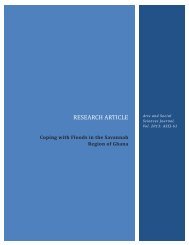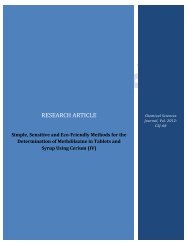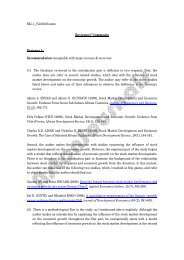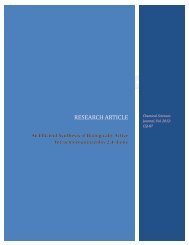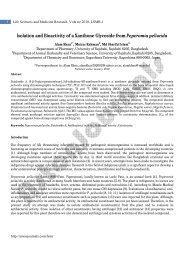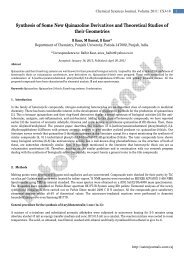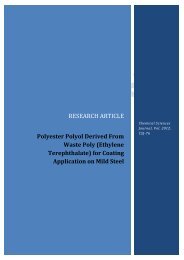RESEARCH ARTICLE - AstonJournals
RESEARCH ARTICLE - AstonJournals
RESEARCH ARTICLE - AstonJournals
- No tags were found...
Create successful ePaper yourself
Turn your PDF publications into a flip-book with our unique Google optimized e-Paper software.
<strong>RESEARCH</strong> <strong>ARTICLE</strong>Chemical SciencesJournal, Vol. 2013:CSJ-106Study of the Thermodynamic Parametersby the Dissolution of Barium Hydroxidein Water through Conductivity Method
Chemical Sciences Journal, Vol. 2013: CSJ-1061Study of the Thermodynamic Parameters by the Dissolutionof Barium Hydroxide in Water through Conductivity MethodSyed A Ali 1* , Muhammad Z Iqbal 2 , Atya Hassan 31Department of Chemistry, University of Karachi, Karachi, Sindh, Pakistan.2Department of Chemistry, Government Degree Science College, Malir Colony,Karachi, Sindh, Pakistan.3Department of Chemistry, Federal Urdu University of Arts, Science and Technology,Karachi, Sindh, Pakistan.*Correspondence: aliazhar325@yahoo.comAccepted: May 9, 2013; Published: June 12, 2013AbstractThe dissolution of Barium hydroxide (Ba(OH) 2) in pure water was used for finding out its thermodynamic parameters byconductivity method. The effect of ionic salts as well as the influence of some mixed solvent (1,2-propanediol and ethanol) werealso studied. It was found that the added ionic salts produced fewer changes in the thermodynamic parameters compared tomixed solvents. Moreover, the combined salts and mixed solvent system collectively changed the thermodynamic parameters moredifferently as compared to the separate systems. These results were compared with the dielectric constant and ionic strengthof the media.Keywords: Barium hydroxide; thermodynamic parameters; conductivity; mixed solvent; dielectric constant.1. IntroductionBarium hydroxide (Ba(OH) 2) is very important due to its industrial applications in different fields. It is used as anadditive in thermoplastic, phenolic resins and PVC stabilizers to improve plastic properties. It is also used as generalpurpose additive for lubricant and grease. It is used in sugar industry, soap manufacturing, fat saponification, fusingof silicates and chemical synthesis of other Ba(OH) 2compounds. The significant role of Ba(OH) 2is also reported inphotographic papers and printing process. It is used in the synthesis of many Chalcones [1, 2]. In synthetic organicchemistry, it is also used for hydrolysis of ester [3, 4] and nitriles [5–7] in preparation of cyclopentanone [8, 9] and indiacetone alcohol [10] etc. Similarly, it is used in the study of endothermic reaction when mixed with ammonium salts.The sparingly soluble salts when dissolved in water dissociate rarely and their degree of dissociation is controlled byvarious factors like temperature, pH and dielectric constant etc. In case of change in temperature, effect related tothe dissociation of Ba(OH) 2follows by the following equation:<strong>AstonJournals</strong>Ba(OH) 2« Ba 12 1 2OH 2The concentration of OH 2 is determined by titrating it with standard HCl solution. The molar solubility “S”of Ba(OH) 2is determined from following equations,Ba 12 (aq) 1 2OH2 (aq) 1 2H 3 O1 (aq) 1 2Cl2 (aq) « Ba12 (aq) 1 2Cl2 (aq) 1 4H 2 OMoles of hydroxide 5 Moles of HCl 5 Liters of HCl 3 [HCl]Moles of Ba(OH) 25 ½ moles of OH 2 where,S 5 Moles of Ba(OH) 2in aliquot/volume of aliquot in liters(1)Co-Publisher: OMICS Group, www.omicsonline.orghttp://astonjournals.com/csj
Chemical Sciences Journal, Vol. 2013: CSJ-1063Figure 1: Titration curve showing the effect of ionic salt (0.6 g NaCl) on conductanceof dissolution of Ba(OH) 2in different % composition in mixed solvent system(water 1 1,2-propanediol) at 10 6 18C.8Conductance (mS)765432100 2 4 6 8 10 12 14 16 18VolumeofHCl(ml)Figure 2 : Titration curve showing the effect of ionic salt (0.6 g NaCl) on conductanceof dissolution of Ba(OH) 2in different % composition in mixed solvent system(water 1 ethanol) at 10 6 18C.Conductance (mS)87654<strong>AstonJournals</strong>32100 2 4 6 8 10 12 14 16 18VolumeofHCl(ml)Co-Publisher: OMICS Group, www.omicsonline.orghttp://astonjournals.com/csj
4 Research ArticleTable 1: Effect of % composition on conductance of dissolution of Ba(OH) 2in different % compositionof water 1 1,2-propanediol in presence of 0.6 g NaCl at 10 1°C while titrated with 0.015 N HCl.Volume ofHCl (ml)PurewaterConductance (mS)% Solvent (1,2-propanediol)0% 2% 4% 6% 8% 10%0 1.99 6 0.02 7.44 6 0.02 7.38 6 0.01 7.06 6 0.02 6.88 6 0.01 6.48 6 0.02 6.14 6 0.031 1.81 6 0.03 7.18 6 0.02 7.07 6 0.03 6.75 6 0.03 6.55 6 0.01 6.17 6 0.01 5.91 6 0.032 1.67 6 0.02 6.91 6 0.02 6.78 6 0.03 6.50 6 0.02 6.30 6 0.02 5.96 6 0.01 5.69 6 0.023 1.54 6 0.02 6.67 6 0.01 6.51 6 0.02 6.23 6 0.02 6.06 6 0.03 5.76 6 0.03 5.50 6 0.024 1.41 6 0.03 6.42 6 0.02 6.24 6 0.03 5.98 6 0.01 5.83 6 0.03 5.56 6 0.02 5.30 6 0.015 1.29 6 0.02 6.20 6 0.02 5.98 6 0.01 5.73 6 0.01 5.58 6 0.01 5.35 6 0.01 5.13 6 0.016 1.18 6 0.01 5.98 6 0.03 5.70 6 0.02 5.50 6 0.02 5.36 6 0.02 5.15 6 0.01 4.94 6 0.037 1.03 6 0.01 5.72 6 0.02 5.41 6 0.02 5.26 6 0.03 5.16 6 0.02 4.95 6 0.02 4.77 6 0.018 0.93 6 0.01 5.49 6 0.01 5.14 6 0.02 5.02 6 0.02 4.95 6 0.01 4.75 6 0.03 4.60 6 0.029 0.82 6 0.02 5.30 6 0.01 4.88 6 0.01 4.77 6 0.03 4.70 6 0.03 4.51 6 0.03 4.43 6 0.0210 0.75 6 0.01 5.32 6 0.01 4.91 6 0.02 4.80 6 0.03 4.73 6 0.01 4.54 6 0.01 4.45 6 0.0111 0.81 6 0.02 5.45 6 0.03 4.97 6 0.03 4.87 6 0.01 4.78 6 0.02 4.60 6 0.02 4.50 6 0.0312 1.00 6 0.02 5.58 6 0.02 5.05 6 0.03 4.93 6 0.01 4.83 6 0.01 4.65 6 0.03 4.53 6 0.0113 1.16 6 0.02 5.70 6 0.03 5.15 6 0.01 5.02 6 0.02 4.90 6 0.03 4.71 6 0.02 4.54 6 0.0114 1.33 6 0.03 5.85 6 0.03 5.23 6 0.01 5.11 6 0.03 4.99 6 0.01 4.76 6 0.02 4.61 6 0.0315 1.50 6 0.02 6.00 6 0.02 5.32 6 0.02 5.19 6 0.02 5.08 6 0.03 4.80 6 0.01 4.70 6 0.0216 1.65 6 0.01 6.10 6 0.01 5.43 6 0.03 5.33 6 0.01 5.17 6 0.02 4.87 6 0.01 4.75 6 0.0217 1.81 6 0.01 6.29 6 0.01 5.54 6 0.02 5.42 6 0.01 5.26 6 0.02 4.93 6 0.01 4.80 6 0.02Table 2: Effect of % composition on conductance of dissolution of Ba(OH) 2in different % compositionof water 1 ethanol in presence of 0.6 g NaCl at 10 18C while titrated with 0.015 N HCl.Conductance (mS)Volume of Pure% Solvent (ethanol)HCl (ml) water 0% 2% 4% 6% 8% 10%0 1.99 6 0.02 7.44 6 0.02 6.95 6 0.03 6.41 6 0.02 5.84 6 0.01 5.64 6 0.02 5.50 6 0.021 1.81 6 0.03 7.18 6 0.02 6.66 6 0.02 6.15 6 0.02 5.64 6 0.01 5.46 6 0.03 5.30 6 0.012 1.67 6 0.02 6.91 6 0.01 6.39 6 0.02 5.94 6 0.02 5.47 6 0.01 5.26 6 0.03 5.11 6 0.013 1.54 6 0.02 6.67 6 0.02 6.11 6 0.02 5.72 6 0.03 5.26 6 0.03 5.05 6 0.03 4.88 6 0.014 1.41 6 0.03 6.42 6 0.02 5.89 6 0.02 5.51 6 0.03 5.06 6 0.01 4.87 6 0.02 4.70 6 0.015 1.29 6 0.02 6.20 6 0.03 5.64 6 0.03 5.31 6 0.001 4.88 6 0.02 4.71 6 0.02 4.53 6 0.026 1.18 6 0.01 5.98 6 0.03 5.41 6 0.02 5.12 6 0.01 4.72 6 0.02 4.58 6 0.02 4.37 6 0.027 1.03 6 0.01 5.72 6 0.03 5.17 6 0.01 4.89 6 0.01 4.56 6 0.02 4.40 6 0.01 4.19 6 0.018 0.93 6 0.01 5.49 6 0.01 4.91 6 0.01 4.68 6 0.01 4.37 6 0.02 4.22 6 0.01 4.02 6 0.019 0.82 6 0.02 5.30 6 0.03 4.62 6 0.02 4.47 6 0.01 4.15 6 0.02 4.07 6 0.01 3.87 6 0.0310 0.75 6 0.01 5.32 6 0.01 4.67 6 0.02 4.52 6 0.02 4.25 6 0.01 4.12 6 0.01 3.92 6 0.0311 0.81 6 0.02 5.45 6 0.02 4.78 6 0.02 4.59 6 0.02 4.32 6 0.04 4.20 6 0.01 4.00 6 0.0312 1.00 6 0.02 5.58 6 0.02 4.87 6 0.03 4.67 6 0.02 4.41 6 0.01 4.28 6 0.01 4.07 6 0.0313 1.16 6 0.02 5.70 6 0.02 4.94 6 0.03 4.75 6 0.03 4.50 6 0.03 4.37 6 0.01 4.16 6 0.0214 1.33 6 0.03 5.85 6 0.01 5.01 6 0.01 4.83 6 0.03 4.59 6 0.02 4.46 6 0.01 4.25 6 0.0215 1.50 6 0.02 6.00 6 0.02 5.08 6 0.01 4.91 6 0.02 4.68 6 0.01 4.53 6 0.01 4.33 6 0.0216 1.65 6 0.01 6.15 6 0.01 5.16 6 0.01 5.00 6 0.01 4.77 6 0.01 4.62 6 0.02 4.42 6 0.0217 1.81 6 0.01 6.29 6 0.01 5.27 6 0.02 5.10 6 0.01 4.85 6 0.01 4.72 6 0.04 4.52 6 0.02<strong>AstonJournals</strong>http://astonjournals.com/csjCo-Publisher: OMICS Group, www.omicsonline.org
Chemical Sciences Journal, Vol. 2013: CSJ-1065Table 3: Difference in the value of DG8, DS8 & DH8 of solution composition verses pure water.Solution compositionH 2O 1 Ba(OH) 21 NaClBa(OH) 2in(H 2O 1 1,2-propanediol)Ba(OH) 2in (H 2O 1 ethanol)Ba(OH) 2in(H 2O 1 1,2-propanediol)1 0.6 g NaClBa(OH) 2in (H 2O 1 ethanol)1 0.6 g NaCl*Inferred from DG8 taken at 108 and 308C.Amountof salt (g)Solvent(%)DG8 at 108C(KJ/mole)DG8 at 308C(KJ/mole)*DS8(J/K/mole)*DH8(J/K/mole)0.05 0 0.68 0.50 9.27 3303.980.2 0 0.66 0.49 8.85 3187.990.4 0 0.65 0.48 8.56 3072.470.6 0 0.62 0.46 7.85 2842.510.0 2 0.93 0.81 5.73 2556.140.0 4 0.97 0.83 6.44 2794.810.0 6 1.07 0.93 6.93 3028.670.0 8 1.12 0.94 8.50 3747.080.0 10 1.13 0.95 8.47 3522.640.0 2 0.99 0.86 7.58 3158.620.0 4 1.03 0.93 6.11 2783.480.0 6 1.11 0.96 8.44 3524.770.0 8 1.12 0.99 7.52 3272.250.0 10 1.14 1.00 7.07 3144.420.6 2 0.66 0.50 7.70 2837.470.6 4 0.67 0.51 8.05 2952.580.6 6 0.69 0.53 8.38 3067.800.6 8 0.72 0.54 9.12 3300.590.6 10 0.73 0.55 9.06 3300.340.6 2 0.73 0.60 6.55 3589.720.6 4 0.75 0.63 5.72 2368.950.6 6 0.76 0.64 5.61 2346.700.6 8 0.76 0.65 5.58 2345.610.6 10 0.78 0.67 5.51 2342.53Figure 3: The effect of NaCl on the Gibbs free energy of Ba(OH) 2in different % compositionof 1,2-propanediol at 10 6 18C.( )38.4638.4438.42<strong>AstonJournals</strong>38.438.3838.3638.3438.320 2 4 6 8 10 121,2-propanediol (%)Co-Publisher: OMICS Group, www.omicsonline.orghttp://astonjournals.com/csj
6 Research ArticleFigure 4: The effect of NaCl on the Gibbs Free energy of Ba(OH) 2in different % compositionof ethanol at 10 6 18C.∆G (KJ/mole)3.2. Effect of mixed solvent systemThe values of DG8, DS8 and DH8 in presence of mixed solvent system (H 2O 1 1,2-propanediol or H 2O 1 ethanol)both in the presence and in the absence of NaCl are also collectively shown in Table 3. It was found that incase of Ba(OH) 2in (H 2O 1 1,2-propanediol, in the absence of NaCl), showed different behaviour comparedto that shown in above (water 1 NaCl) system where the increase in % composition of 1,2-propanediolwere generally increased values of DG8 and DS8. However, the values of DH8 were found to be nonlinear(due to the determination of DG8 in a small difference in temperature taken at 10 and 308C). In case ofBa(OH) 2in (H 2O 1 ethanol) only DG8 showed similar trend compared to 1,2-propanediol system. HoweverDS8 and DH8 values were found to be nonlinear (due to the determination of DG8 in small difference intemperature).3.3. Effect of ionic salt 1 mixed solvent systemIn case of Ba(OH) 2in (H 2O 1 1,2-propanediol 1 NaCl) system the same pattern was found i.e., only DG8 valueswere increased linearly by increasing % composition of 1,2-propanediol. Whereas, both DS8 and DH8 were linearlydecreased even at such low difference of temperature. Similarly Ba(OH) 2in (H 2O 1 ethanol 1 NaCl) system thevalues of DG8, DS8 and DH8 were generally increased by increasing % composition of ethanol.<strong>AstonJournals</strong>3.4. Qualitative characteristicsIn the experiment the initial conductance (in absence of titrant HCl) increased by increasing the amount of NaClwhere as the initial conductance decreased by increasing % of solvent (1,2-propanediol or ethanol) at 108C,which is shown in Figures 5 and 6. The same result was obtained for 308C. This trend is also justified by thedielectric constant values of water, 1,2-propanediol and ethanol which are 80.0, 30.2 and 24.6, respectively whichare given in Table 4. These dielectric constant values suggest that the influence of ionic salt (NaCl) enhances theconductance in high dielectric medium compared to solvent having low dielectric medium (hence offering lessconductance values).http://astonjournals.com/csjCo-Publisher: OMICS Group, www.omicsonline.org
Chemical Sciences Journal, Vol. 2013: CSJ-1067Figure 5: The effect of NaCl on the initial conductance of Ba(OH) 2in different % compositionof 1,2-propanediol at 10 6 18C.8Initial conductance(mS)76543210(%)Figure 6: The effect of NaCl on the initial conductance of Ba(OH) 2in different % compositionof ethanol at 10 6 18C.Initial conductance(mS)87654321<strong>AstonJournals</strong>0(%)Co-Publisher: OMICS Group, www.omicsonline.orghttp://astonjournals.com/csj
8 Research Article4. ConclusionThe thermodynamic parameters of Ba(OH) 2in mixed solvent systems have been studied. The same Ba(OH) 2may beused with different solvents to find the conductance and correlate it with dielectric constant values as well as thethermodynamic parameters.Competing InterestsThe authors declare that they have no competing interests.Authors’ ContributionsSAA proposed the experiment, MZI worked under supervision of SAA and AH helped in discussion and manuscriptpreparation.AcknowledgementMZI is grateful to the Department of Education and Literacy, Government of Sindh, Karachi, Sindh, Pakistan, for grantingpermission for this research work. The same author also acknowledges Dr. Syed Nawazish Ali for providing himvaluable guideline to accomplish this manuscript.ReferencesTable 4: Comparison in the value of DG8, DS8 & DH8 for different solution composition.Solution compositionDG8 at 108C(KJ/mole)DG8 at 308C(KJ/mole)*DS8(J/K/mole)*DH8(J/K/mole)H 2O 1 Ba(OH) 21 0.6 g NaCl 0.62 0.46 7.85 2842.51Ba(OH) 2in (H 2O 1 10%1,2-propanediol)1.13 0.95 8.47 3522.64Ba(OH) 2in (H 2O 1 10% ethanol) 1.14 1.00 7.07 3144.42Ba(OH) 2in (H 2O 1 10%1,2-propanediol) 1 0.6 g NaClBa(OH) 2in (H 2O 1 10%ethanol) 1 0.6 g NaCl*Inferred from DG8 taken at 10 and 308C.0.73 0.55 9.06 3300.340.78 0.67 5.51 2342.53Dielectricconstant80.0(pure water)30.2(1,2-propanediol)24.6(ethanol)[1] Zangade S, Mokle S, Vibhute A, Vibhute Y, 2011. An Efficient and Operationally Simple Synthesis of Some New Chalcones byUsing Grinding Technique. Chemical Sciences Journal, Volume 2011/CSJ-13.[2] Shorey S, Chaoudhary PC, Intodia K, 2012. Microwave irradiation synthesis of various substituted chalcones using variousheterogeneous catalysts under solvent-free conditions and their biological studies. Chemical Sciences Transactions,2(2): 343–348.[3] Anderson MO, Moser J, Sherrill J, Guy RK, 2004. A convenient procedure for parallel ester hydrolysis. Synlett, 13: 2391–2393.[4] Dalton DR, 2011. Foundations of Organic Chemistry: Unity and Diversity of Structures, Pathways, and Reactions. Wiley,p. 1163.[5] Bascop S-I, Laronze J-Y, Sapi J, 2003. Synthesis of 2-aminopropyl-3-indole–acetic(propionic) acid derivatives. Archive forOrganic Chemistry. pp. 46–61.[6] Ropp RC, 2011. Encyclopedia of the Alkaline Earth Compounds. Elsevier, p. 123.[7] Varma RS, 1999. Solvent-free organic syntheses using supported reagents and microwave irradiation. Green Chemistry,1: 43–55.[8] Vojtko J, 2005. New way of production of cyclopentanone. Petroleum & Coal, 47(1): 1–4.[9] Yan B, Spilling CD, 2008. Synthesis of cyclopentenones via intramolecular HWE and the paladium-catalyzed reactionsof allylic hydroxy phosphonate derivatives. Journal of Organic Chemistry, 73(14): 5385–5396.<strong>AstonJournals</strong>http://astonjournals.com/csjCo-Publisher: OMICS Group, www.omicsonline.org
Chemical Sciences Journal, Vol. 2013: CSJ-1069[10] Raso AG, SInisterra JV, Marinas JM, 1982. A new Ba(OH) 2catalyst for synthesis of diacetone alcohol. Reaction Kinetics andCatalysis Letters, 18(1–2): 33–37.[11] William BE, Kirschmbaum LJ, Ruekberg BJ, 2000. Determination of K sp, G 8 , H 8 and S 8 for the dissolution of calcium hydroxidein water. Journal of Chemical Education, 77: 1039–1040.[12] Ali SA, Hassan A, 2012. Solvent effect on the thermodynamic parameters of Ca(OH) 2by conductivity method. Journal ofPhysical Chemistry and Biophysics, 3: 1–4.[13] Hansen WC, Pressler EE, 1947. Solubility of Ca(OH) 2and CaSO 4·2H 2O in dilute alkali solutions. Industrial and EngineeringChemistry, 39(10): 1280–1282.[14] Weiping M, Paul WB, Dexiang S, 1992. Solubility of Ca(OH) 2and CaSO 4·2H 2O in the liquid phase from hardened cement paste.Materials Research Laboratory, 22: 531–540.[15] Michael DE, Suter RW, 1988. Determining of solubility of Ca(OH) 2using 45Ca as tracer. Journal of Chemical Education,65(3): 279.[16] Wang Z, Konigsberger E, 1998. Solubility equilibria in the uric acid-sodium urate-water system. Thermochimica Acta, 310(1):237–242.[17] Chambers PA, Prepas EE, Ferguson ME, Serediak M, Guy M, Holst M, 2001. The effects of lime addition on aquatic macrophytesin hard water: in situ and microcosm experiments. Freshwater Biology, 46(8): 1121–1138.[18] Aktaş AH, Yaşar S, 2004. Potentiometric titration of some hydroxilated benzoic acids and cinnamic acids by artificial neuralnetwork calibration. Acta Chemica Slovenica, 51: 273–282.[19] Trejo González JA, Longinotti MP, Corti HR, 2011. The viscosity of glycerol–water mixtures including the supercooled region.Journal of Chemical and Engineering Data, 56(4): 1397–1406.[20] Holba V, 1999. Solubility and thermodynamic functions of transfer for [Cr(en) 2Cl 2]·[Cr(C 6H 5NH 2(NCS) 4] from water to waterorganicmixed solvents. Chemical Papers, 53: 227–232.<strong>AstonJournals</strong>Co-Publisher: OMICS Group, www.omicsonline.orghttp://astonjournals.com/csj


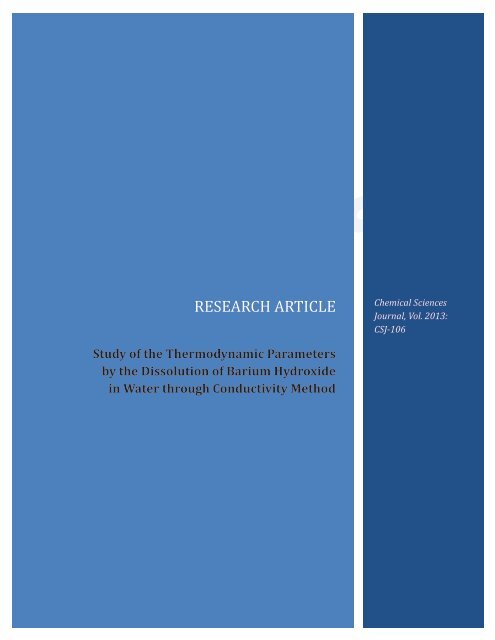
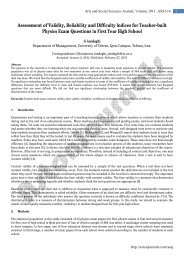
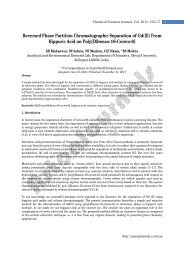
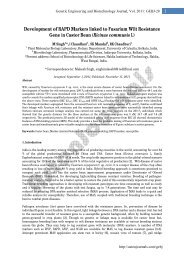

![[1,4]-benzodiazepine-2-one Derivatives as Potent - AstonJournals](https://img.yumpu.com/49117784/1/184x260/14-benzodiazepine-2-one-derivatives-as-potent-astonjournals.jpg?quality=85)
